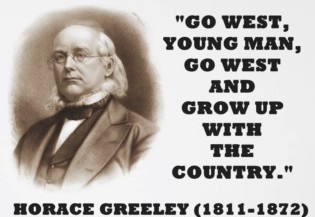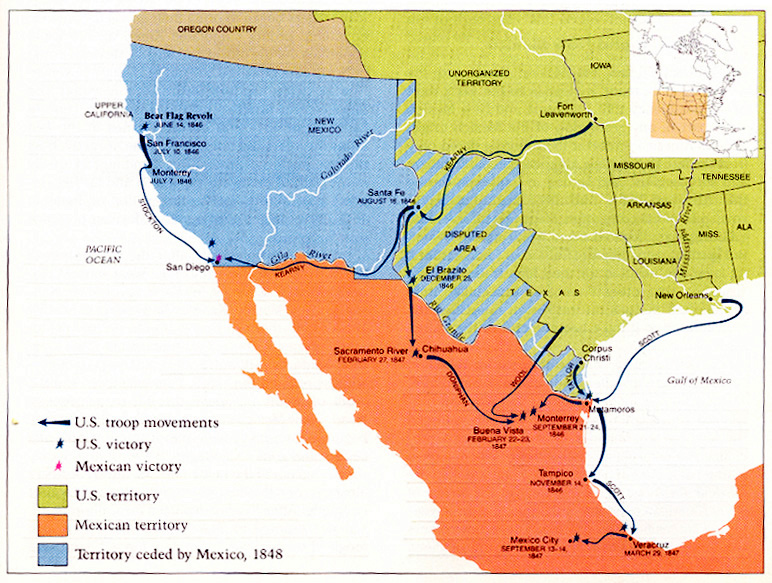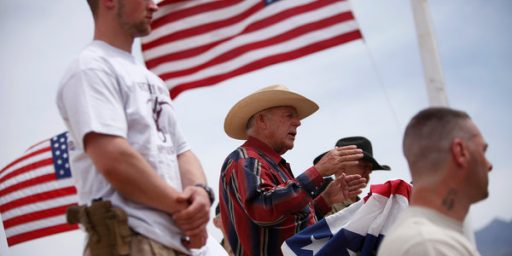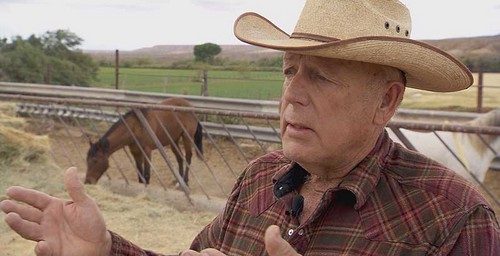The Basics of Federal Land Ownership in Two Maps
How did the west become part of the US?
\ Understanding, at least in part, why so much of the American west is owned by the government, as illustrated by this map (full version here):
Understanding, at least in part, why so much of the American west is owned by the government, as illustrated by this map (full version here):
Can be explained by this map:

Most of the western US (indeed, south-central as well, i.e., from the current border of Louisiana westward across Texas) used to be part of Mexico. East Texas became independent after the Texas Revolution of 1836 (as did, theoretically, the disputed area on the map above). After the Mexican-American War of 1848, eastern Texas, the disputed area and the rest of the blue territory became part of the US. (The remainder of Arizona was later purchased by, you guessed it, the federal government of the US from Mexico).
Now, one can argue that the US government should have sold off the land in question over the last century and a half, but there is no disputing the fact that the only reason that the territory in question is part of the United States (including the land upon which Cliven Bundy lives and where he has been grazing his cattle with out paying for the privilege) is because of the actions of the federal government of the United States. Further, the creation of states out of that territory required acts of Congress, under the authority of the federal constitution.
Our national mythos is so wrapped up in the notion that westward expansion was the product of rugged individuals moving into virgin lands that we forget the actually history (if we ever really knew it in the first place).







Excellent post Steven. We the people of the United States either bought the land outright and paid for wars to obtain it. Bundy is a welfare cowboy and would still be a welfare cowboy even if he was paying his grazing fees. The grazing fees on federal land average $1.60 a head. It is estimated that the cost of grazing them on private land would be over $16.00 a head. Sorry, but that qualifies as welfare in my book.
Here in Oregon the biggest problem we have on BLM land is well armed people growing pot. There are areas where the general public is advised not to go because of this activity but the BLM budget has been cut so drastically they can’t do anything about it.
The West is the biggest ongoing Big Gumint program in history. Without federal water projects much of the West would be desert. Oddly enough, the West also seems to be home of most of our libertarians and conservative Republicans. Their motto seems to be “Thanks, US Government, for opening the West, rounding up the original inhabitants, and making it live able through your water projects. Now get the hell out!”
One can argue this, but to do so effectively one will also have to provide the concept of someone willing to buy it from the Fed. That’s part of the problem – it’s fairly useless land, unless you want to graze animals. And even Bundy can’t be bothered to actually _buy_ the territory he grazes; he just wants to _use_ it free of charge and leave the upkeep to the taxpayer. That’s why he’s scum.
@legion: It is very likely that a conservation about said land would render any number of reasons, such as those you note, as to why the land has remained in federal hands. This I do not dispute. I just figure it is fair to note that it is a discussion that could be had and that there is not automatic reason why the land in question remains in federal hands.
@Steven L. Taylor: Steven, keep in mind that at least some of this land was land granted to individuals and then reverted back to the federal government when the grantees couldn’t make a go of it.
The federal government is ultimately responsible for the vast majority of the land acquired from the Louisiana Purchase on westward. On its own, it has little explanatory power towards the disparities of federal land ownership. The explanatory factors are due primarily with a combination of (a) an increased reluctance on the part of the federal government to continue its policy of selling the land and (b) that a lot of it is inhabitable. Some land because of (a), some because of (b).
@Stonetools: Yup. God, guns, and guts my arse. Federal troops, federal money, and federal infrastructure development won the West.
@trumwill: As I said, “basics”–I wasn’t trying to explain it all.
It is helpful, I think, to remind people how the lands in question became par of the country in the first place.
What’s funny to me is how completely and utterly divorced the bullhorn debates on western land management issues are from the actual issues and concerns of western land management issues. Both sides should have more mixed feelings about it than they do.
@trumwill: Will….”Herb” here. Have to say, glad to have read this:
Yes.
I’m coming around on (a)……although I really do think that the reluctance you describe is mainly the result of (mostly non-partisan) political pressure. No drilling at ANWR. No snowmobiles at RMNP. Etc.
Another factor that didn’t occur to me the other day: the number and size of Indian reservations. Much of New Mexico and Arizona are “owned” by the feds….on behalf of sovereign nations they do not control.
@James Pearce: My impression is that the federal ownership of land results in more resource exploitation rather than less. The local populations have much more mixed feelings on the issue. In Montana in 2012, the Republicans ran on Drill, Baby, Drill and the Democrats ran on caution… and the Democrats won in an election where Romney carried the state by more than ten points.
The snowmobiling thing is interesting. When I lived out there they had a whole lot of debates back and forth on it. The cloud over the whole thing, of course, was the degree to which their opinions – before or after – were perceived not to matter a bit for huge chunks of the land. Often land they moved specifically to be near (which brings us around to the fact that public ownership of the land, in and of itself, is not a terribly unpopular thing even in my solid Republican county).
Like I said in the subsequent comments, the issues here are a lot more complicated than the red/blue divide when folks want to look beyond broad and often ugly stereotypes. As Michael Cain said elsewhere, if Nevada were in charge of grazing they’d be harder on grazers than the feds are. My impression is that the same is true of Idaho and Montana. Maybe Wyoming, too, but they have bigger issues over there.
BTW, on the first map of the post, the reservations are in red.
@Steven L. Taylor:
First let me say that, I for one, am proud to live in El Norte (aka California).
American have long bought the myth of the New Frontier and the image crafting of Hollywood. As we out here in the West know all too well, the West is a place where many people fled to, to recreate themselves, to start over. Every city in this country has those sorts of people but the West seems to have more of them. Far from being the rugged individualists of those Saturday afternoon matinees, many of the migrants to the West were grifters or just regular people looking to start anew. Cliven Bundy is an Area 51 type of Westerner – a person who has created for himself a shadow world, one where all that is wrong in his life is the result of a government conspiracy against him.
I live in an area that has many Hispanic/Latino people, a fair share of whom are probably illegal, and I can say without reservation (no pun intended) that I prefer my neighborhood and environs to having a somewhat delusional guy like Bundy as a neighbor.
@al-Ameda: Here in Washington County west of Portland we also have a large Hispanic population many of which have been here so long they don’t even speak Spanish anymore. I’m sure there are many undocumented Hispanics but I think what most people don’t realize is that if we were to deport them all the rest of us would starve to death. They are friendly family oriented people which is more than I can say for most the Anglo s..
@Ron Beasley:
The same here Ron. When my daughter started school here in our neighborhood, about half the students were Hispanic and there was bilingual instruction everyday to help these kids make the transition – and they did, successfully. It is a group of hard working families.
There is one glaring error in this article. East Texas did not become part of the U.S. In 1836, it became the Republic of Texas, a sovereign nation, after the defeat of Santa Anna at the Battle of San Jacinto on April 21, 1836. The Republic of Texas joined the union in 1845, an event many Texans today regret.
@W. M. Welch: You are correct–I meant to say that east Texas left Mexico in 1836, not became part of the US (although they did try in 1836). In an attempt to explain the disputed area (which Texas fully claimed from the get-go, even if they did not actually control it) I compressed time in the sentence.
Of course, apart from the rhetorical statements made by Texans on this count, I sincerely doubt all that many actually regret joining the US (and I say that as as an ex-pat Texan).
@W. M. Welch: Whatever one thinks of Texas now, life in the Republic of Texas… wasn’t good. It would have taken Texas a whole lot longer to get to the standard-of-living place it is now had it not been a component of a much larger union. (As is true of almost all states, or all of them.)
@Steven L. Taylor: Indeed. Even now (well, 2011), thee quarters of Texans oppose independence, compared to 14% who favor it. (PDF)
@Trumwill:
That sounds about right. Who would you rather lease your oil field from? The private land-owner who wants some oil money or the federal land-owner who wants to see you make some oil money?
The other thing, too, of course is that the feds have more resources than anybody. If they’re not greasing the wheels of commerce and industry, then no one is.
But alas, you’re right:
One “local” issue in my area that I can speak on is that of the pine beetle. These little bastards have chewed down through Wyoming all the way to the Four Corners, killing entire forests that are just sitting there, miles and miles of dead wood just waiting for a spark.
Me, I say cut them down. Spend a bunch of money, get a bunch of lumberjacks, build a bunch of sawmills, and extract, extract, extract. Make mulch for the “grow food not lawns” crowd, sell it to Ikea, grind it up and make ethanol out of it. This stuff can be used before it all burns down.
But the feds say no. No money. No will. And all the local population can do is build firebreaks.
Also: The Indian reservations. I noticed it on the map first, but also thought about the debates over gas exploration at Chaco Canyon. I can’t remember exactly how that’s going down, but it’s not just a negotiation between the feds and the gas companies, but also the Navajo.
So yes, as you say, more complicated than red/blue.
Of course, Steven, this is all constitutional, or so I hear on Facebook. (Sorry, couldn’t resist)
@David in KC: oops, typing on my iPad outside and the glare from the sun is a bit much. That should have been unconstitutional.
@David in KC: Indeed. Facebook i teeming with historians, constitutional scholars, and political scientists!
@Steven L. Taylor: Present company excluded, of course.
Thank you again Steven. I just linked to your post on a rant I did at The Moderate Voice.
@Stonetools: really, guess they don’t actually vote?
http://www.google.com/imgres?imgrefurl=http%3A%2F%2Fblogs.e-rockford.com%2Fapplesauce%2F2012%2F07%2F18%2Fhave-you-ever-wondered-why-republican-states-are-red-and-democratic-states-blue%2F&tbnid=kogoNh_5o6AH5M:&docid=4OfAvveKmnlMqM&h=242&w=340
My guess is that transference to the state governments would result in far worse exploitation and general destruction. Megacorps can bribe state governments far more easily.
Damn hipsters…
@anjin-san: my hip sometimes bugs me, does that count?